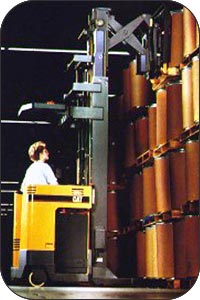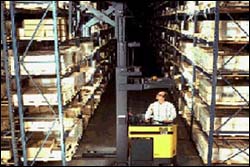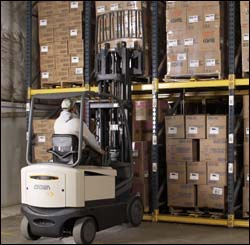Powered Industrial Trucks (Forklift) eTool
Understanding the Workplace » Narrow Aisles

Conventional rack storage systems were designed for the counterbalanced lift truck which requires about a 12 ft (144 in) aisle width. Narrow aisle storage systems provide more storage space, but require reach trucks and order pickers to operate in much narrower aisle widths.

Reach trucks are a type of Class II electric motor narrow aisle truck. These trucks are used for high tiering, which involves storing material in multiple tiers high off the ground.
Potential Hazards
-
Danger of overloading, especially on high lift.
-
Danger of tipover.
Requirements and Recommended Practices
-
Check pallet weight before lifting.
-
Place heaviest loads on the bottom racks, and lighter loads on the top.
-
Do not exceed the load capacity of the lift truck with attachments such as a pantograph attachment. (Figure 2)
-
Do not lift the heaviest load to the maximum lift or stacking height. There may be a loss of stability.

Order picker trucks are another type of Class II electric motor narrow aisle truck. These trucks are designed to lift the operator to retrieve items.
Potential Hazards
-
Falling
Requirements and Recommended Practices
-
Wear appropriate fall protection equipment that is properly fitted and adjusted. Ensure that employees are trained in the proper use of the fall protection equipment.
Additional Information:
-
OSHA strongly encourages the use of body harnesses on elevated platforms of powered industrial trucks. OSHA Standard Interpretation: Fall protection requirements for elevated platforms of powered industrial trucks; body belts versus harnesses. (June 28, 2004)
Potential Hazards
-
Falling loads
-
Tipover
Requirements and Recommended Practices

OSHA's Powered Industrial Truck Standard includes a series of rules for safe stacking:
-
Only stable or safely arranged loads shall be handled. Caution shall be exercised when handling off-center loads which cannot be centered. [29 CFR 1910.178(o)(1)]
-
Only loads within the rated capacity of the truck shall be handled. [29 CFR 1910.178(o)(2)]
-
The long or high (including multiple-tiered) loads which may affect capacity shall be adjusted. [29 CFR 1910.178(o)(3)]
-
Trucks equipped with attachments shall be operated as partially loaded trucks when not handling a load. [29 CFR 1910.178(o)(4)]
-
A load engaging means shall be placed under the load as far as possible; the mast shall be carefully tilted backward to stabilize the load. [29 CFR 1910.178(o)(5)]
-
Extreme care shall be used when tilting the load forward or backward, particularly when high tiering. Tilting forward with load engaging means elevated shall be prohibited except to pick up a load. An elevated load shall not be tilted forward except when the load is in a deposit position over a rack or stack. When stacking or tiering, only enough backward tilt to stabilize the load shall be used. [29 CFR 1910.178(o)(6)]
In addition, the following are recommended:
-
Move forks as far apart as the load will permit. Be sure the load is centered and the forks are completely under the load before lifting.
-
When stacking use only enough backward tilt to stabilize the load.

